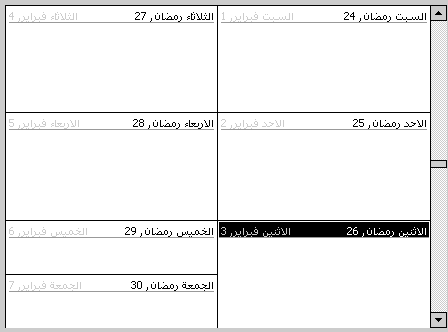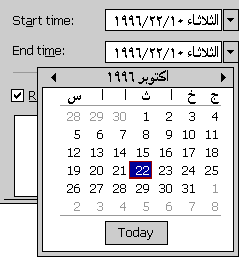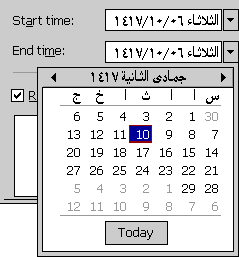 Show All
Show AllThe features described in this Help topic are only available if support for a right-to-left language is enabled through Microsoft Office Language Settings. To enable right-to-left features, you must be running a Microsoft Windows operating system that has right-to-left support.
The short and long date formats, for example, 11/01/01 or November 1, 2001, follow the date formats selected in the operating system's settings. The language of the month and weekday names depends on the country/region selected in the Regional Settings or Regional Options dialog box ( Windows Control Panel, Regional Settings or Regional Options icon) and on the calendar selected in the operating system. As a result, you could see right-to-left language or English Gregorian calendar month names, or translated month names.
Notes
Hijri month names are always in Arabic, as provided by the operating system.
Outlook supports Hijri dates that are between 1/1/1010 and 30/12/3997 and Gregorian dates that are between 4/1/1601 and 8/31/4500.
Outlook supports left-to-right and right-to-left calendar layouts. This layout affects the Day/Week/Month views. The right-to-left calendar layout displays days in the weekly and monthly views in mirror image view compared to left-to-right layout. The first day of the week shows on the right, and days increment as you go to the left. Date Navigator supports both layouts. When multiple Date Navigators are selected to display multiple month information, the layout of these months could be left-to-right or right-to-left. Timeline view supports only left-to-right calendar layout.
 About right-to-left calendar views
About right-to-left calendar views
The monthly calendar view is affected by the calendar setting in the operating system.
You can view both calendar formats in this view. If this option is selected, the primary calendar appears on the right side of every cell, and the secondary calendar on the left side. The first cell will have both month names, and the beginning of each month in every format will display the corresponding month name.
In the right-to-left calendar direction setting, the first day is at the top-right corner and the last day is at the bottom-left corner. This is the opposite of the left-to-right layout. This example shows a right-to-left weekly view with Hijri as the primary, and Gregorian as the secondary, calendar.

 Dual calendar view
Dual calendar view
You can display dual calendar information in the Day/Week/Month views of Calendar. In the Week and Month views, information from both calendars will be available in every day cell.
The primary calendar information is displayed at the top-right corner of the day cells. Secondary calendar information is displayed as unavailable at the top-left corner of the day cells.
Notes
When the primary calendar is not Gregorian, the format of the secondary calendar depends on the country/region setting in the Regional Settings or Regional Options dialog box. This could be any of the available Gregorian calendar formats for that country/region.
When using dual calendars, you can view either calendar in its Day/Week/Month views. Some views can display information from each calendar. Additionally, date information in Table views can be displayed in either calendar.
 About the
right-to-left features in Date Navigator
About the
right-to-left features in Date Navigator
Date Navigator can be displayed in several views, depending on your choice of primary calendar and layout.

Date Navigator with the primary calendar Gregorian and a left-to-right calendar layout.

Date Navigator with the primary calendar Hijri and a right-to-left calendar layout.
Microsoft Outlook uses abbreviations in Date Navigator for the names of the days of the week. About right-to-left features and the date parser
About right-to-left features and the date parser
You can specify dates in multiple formats, including specifying a date by using the English day and month names, or by using right-to-left language day and month names. The date parser supports Arabic, English Gregorian, Hebrew, and Arabic-only Hijri month names. If you type a date using the day/month/year number format, the date parser will take you to that date in the current or primary calendar. However, you can specify a specific date by using month names that belong to the secondary calendar, and the date parser will take you to that day.
However, you can type a specific primary or secondary calendar date, and the date parser will be able to interpret it and move the calendar to that date.
For example, if the primary (system) calendar is Gregorian
and the secondary calendar is Hijri, and you type 2/1/99 in the Date
field of the Go To Date dialog box (View menu, Go To
submenu in Day/Week/Month calendar view), the date parser will interpret
it as 2 January 1999. If the primary calendar is Hijri instead, the date
parser will interpret it as 